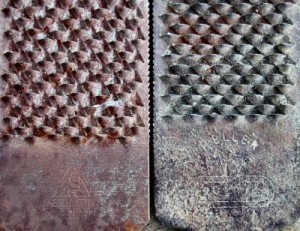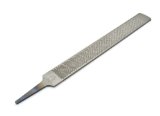 Trimming hooves is hard work and requires a fair amount of strength, so why not make it easier by treating yourself to a nice, sharp, high-quality rasp? Lower quality rasps cost less, but aren’t very sharp even when new, and quickly get even duller with use.
Trimming hooves is hard work and requires a fair amount of strength, so why not make it easier by treating yourself to a nice, sharp, high-quality rasp? Lower quality rasps cost less, but aren’t very sharp even when new, and quickly get even duller with use.
Which rasp to choose?
I’ve been using Heller Legend 14†hoof rasps for some time, but Bellota, Simonds, and Wood-Miller brands are also excellent quality at reasonable prices – ranging from the Simonds Black Master at around $25 each to the Wood-Miller at around $17. Bellota and Heller Legend rasps are in the middle of the pack, at around $20 each. The higher priced rasps in this group tend to stay sharp through more trims, so you get what you pay for.
Some rasp manufacturers offer two or three different types of 14†hoof rasps – usually an aggressive-tooth design, sometimes a medium grade, then a finishing rasp with a shallower bite. A finishing rasp can be a good choice for someone just learning to trim, as it takes less strength to use, removes less hoof with each stroke, and leaves a smoother finish. You don’t need multiple rasps to do a good job, so just choose the type that fits your trimming style.
Simonds makes a high-quality 10″ rasp for trimming miniature horses – if you’re having trouble maneuvering a 14″ rasp around under your pony’s belly, try a mini rasp!
Does the Rider’s Rasp work?

The Rider’s Rasp is a little like a rasp with training wheels – it isn’t as versatile as a plain hoof rasp but might be perfect for someone who wants to round the hoof wall and smooth out minor chips. At around $35, the Rider’s Rasp is nearly double the cost of a professional-quality hoof rasp, but replacement blades are about $30 for two pairs. If a tool like the Rider’s Rasp helps you get started doing your own hoof trimming, or is just what you need, then I’d say it’s worth the money.
Horse Journal gave the Rider’s Rasp a thumbs-up in a May 2009 article.
What about accessories?
I use a Thera Flex Hand Saver rasp cover, a rubber cap that fits over the blunt end of a rasp. The cap is easier to grip than the bare end of the rasp and can be transferred to a new rasp when your old one gets dull. You can also wrap the end of the rasp with a generous layer of Vetrap or duct tape.
 You’ll want to get a rasp handle that fits over the pointed end, or tang, of the rasp.  I use a plain wooden twist-on handle, although there are fancier handles with plastic or aluminum grips. Rasp handles with a fatter grip may be more comfortable for you if you have stiff or painful fingers.
You’ll want to get a rasp handle that fits over the pointed end, or tang, of the rasp.  I use a plain wooden twist-on handle, although there are fancier handles with plastic or aluminum grips. Rasp handles with a fatter grip may be more comfortable for you if you have stiff or painful fingers.
Especially if you don’t use your rasp very often, a generous coating of spray-on dry lubricant (such as DuPont Teflon Multi-Use Dry Wax Lubricant) after each use will help prevent rust from shortening the life of your rasp.
Where to buy?
Most farrier supply stores carry a wide selection of rasps and accessories. I buy most of my tools and supplies from
but
also carries several brands of good-quality rasps, and plain wooden twist-on rasp handles.
How long does a hoof rasp last? How do I know when it’s time to switch to a new rasp?
High-quality rasps usually last through 15-20 trims on a medium-size horse before they become dull. You can certainly use a rasp longer than that, but you’ll start to notice that it takes more effort to get the job done.
When you decide your old rasp is ready for retirement, transfer your rasp handle and Thera Flex Hand Saver to your new rasp. You might want to save your old rasp for rasping off clinches when pulling shoes, or for removing Equicasts. Or, pass a used rasp along to someone who wants to try trimming their own horse!
Tags: hoof trimming, product reviews, tools
-
Helpful blog, bookmarked the website with hopes to read more!
Comments are now closed.

1 comment